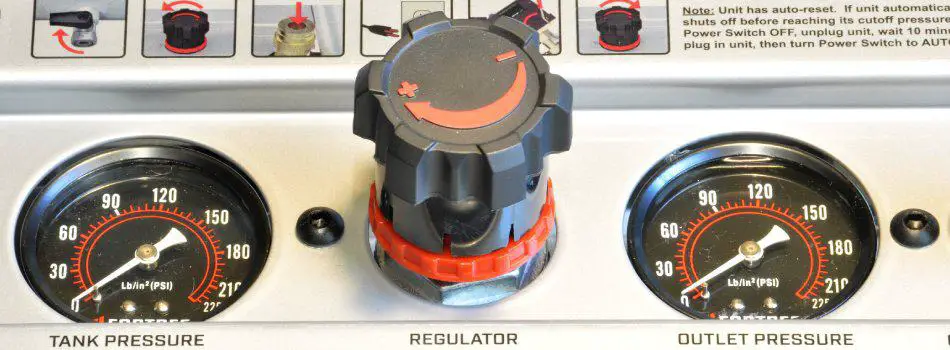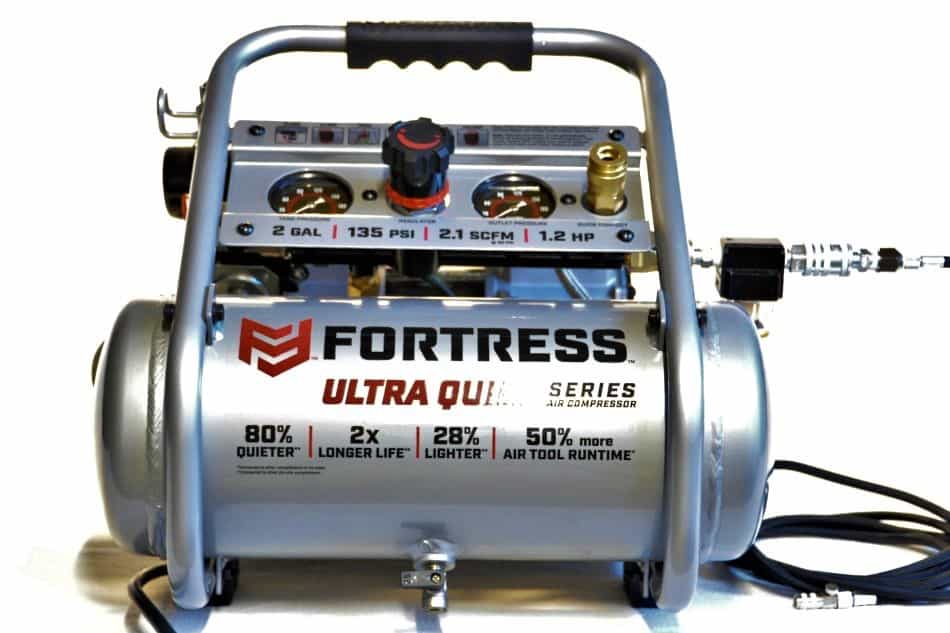In my opinion, it’s better to airbrush with a regular shop air compressor then an “airbrush specific” compressor. At least if you don’t have problems with the noise, and won’t need to transport it often. But even if you do, they make smaller compressors for pneumatic nail, and staple tools that work wonders for airbrush use. Not to mention, how quiet some of the smaller shop compressors are…
So, Yes!
You can use basically any regular air compressor with an airbrush. It’s even better sometimes to use a large compressor for airbrushing, as they are typically equipped with a larger air tank, and a stronger motor. But you will need some items to make a normal compressor work right with an airbrush.
To which we will be digging into shortly…
I personally use a small shop compressor for all my airbrush work, and I couldn’t be happier. The cost of my small shop compressor was much lower than a majority of the airbrush compressors of the same size or smaller, and the overall value provided was equal to, or greater then what a high end airbrush compressor would have provided (In my opinion).
Plus, common shop compressors, similar to the one you probably have, will not only power an airbrush well, but it will likely power commonly used pneumatic power tools as well. This makes your compressor multifuncional over the “airbrush specific” compressors available on the market today. As the airbrush specific compressors are commonly to weak to power anything other than an airbrush.
Because of the benefits of a regular shop compressor, I actually recommend beginner airbrush artists to opt for a small shop compressor instead of an airbrush specific compressor as they are multifunctional, and will likely last much longer then the majority of airbrush specific compressors out there. Especially the ones that are not equipped with a tank.
That being said, let’s discuss what you will need in order to operate your airbrush using your current air compressor.
Items To Make Any Compressor Work With An Airbrush
Before you can airbrush with your current air compressor you will need a few things. If you have them already, then great! If not, thats okay to, I’ll guide you through what you’ll need.
After you get the necessary items below I suggest you take a look at my latest post on “How to connect an airbrush to any shop compressor” for guidance on setting up the items listed below for optimal performance.
Connectors & Adapters

You’ll likely need a few couplers & plugs in order to piece together your air line. But depending on your intended layout the amount of connections will differ from one person to another.
Typically common shop compressor plugs & couplers will work for connection points throughout the air line until you go to connect your “airbrush” air hose to the end of the line. But as long as you buy the right airbrush air hose, the connector needed will be included. (Link to the airbrush air hose I use, that came with an adapter will be linked below under “Air Hoses”)
But if you already have an airbrush specific air hose, without the adaptor. Then you’ll likely need a 1/4″ to (Whatever size your airbrush airline is, usually 1/8″) (Female / male) adaptor.
For more information on the options you have in terms of Couplers & Plugs Take a look at this post by toolguyd. I’ll meet you down under “Regulators” when you get back.
Pressure Regulator

Next on the list,
You’ll need a functioning pressure regulator that can manage a PSI range from 10 psi to 80 PSI. PSI levels depend on multiple factors… For an in-depth guide on how to set the PSI for an airbrush do check out my latest post on the topic: How to set the PSI for an airbrush.
But simply put you’ll need to be able to adjust your air pressure depending on many different factors (factors listed in post about setting psi for an airbrush…).
I say functioning because well, a majority of the air compressors that I’ve seen that are older then a few years commonly have a pressure regulator, but it doesn’t work…
However, if you’ve got a working one, then perfect!
A pressure regulator is likely the most important part when it comes to setting up a normal compressor to power an airbrush. As an airbrush is very sensitive to different pressure levels.
A good pressure regulator for airbrush use is listed Here on amazon. But you need to ensure it will handle the pressure levels your compressor can output. However, next we will be discussing moisture traps, and some come equipped with a pressure regulator as well. If you find you need both It might be better to opt for This One.
Moisture Trap
Next, the moisture trap
I’m assuming your not going to want any moisture or gunk making its way onto your art piece, Right?
Well, a moisture trap will help to filter out any moisture, oil and other gunk that is likely to build up inside the compressor storage tank/s. A Moisture trap will prevent any moisture and other gunk from making its way onto your work.
You do have a few options when it comes to moisture traps.
The first is placed throughout the air line. Commonly mounted on a wall, or placed at the start of the air line (at the compressor).
The second is placed just before the airbrush. It’s much smaller than the other option, and typically cheaper. But can get in the way, as it is going to sit in your hand as you airbrush.
Air Hoses

Your going to need an airbrush specific air hose that will connect directly on to your airbrush at one end, and onto the end of your air line at the other end.
Also you may want to consider using a “shop air hose” / “Regular air compressor air hose” as well, if you intend on airbrushing some distance way for your compressor. (Check out the post linked to below for an example of my air line layout.)
My related article titled: How to connect an airbrush to any air compressor. Provides a few examples as to how I use both an airbrush air hose, as well as a shop air hose to get the distance I need when working far from the compressor.
The airbrush air hose I use is listed Here on amazon, and it comes with a connection adapter to make connecting it to a 1/4″ plug a breeze.
The Downside To Using A Large Compressor To Airbrush
Though larger shop compressors have many benefits when it comes to airbrushing. They do have their pitfalls as well.
Noise
Noise is a big factor when it comes to using shop compressors, as noise typically isn’t a consideration when in the manufacturing process of shop compressors. Simply because shops are usually noisy to begin with.
That being said, there are a few options that are just as quiet as airbrush specific compressors, and are cheaper as well. But if noise isn’t going to be a bother then great!
Weight & Size
The second issue with a regular compressor is that they are usually big, and weigh a ton. Well, not that much (depending on the compressor). But they typically weigh more than airbrush specific compressors. Even the smaller shop compressor. Though not by a lot.
Final thought
If either weight or noise is going to be an issue for you with your current compressor, then be sure to check out my #1 Airbrush compressor recommendation before you spend the money on an expensive airbrush specific compressor.
Conclusion
To finish this off,
You can use any air compressor for airbrushing purposes. Don’t let people tell you, you need to get an “Airbrush specific” compressor. The major difference between an air compressor that is labeled as an airbrush compressor, and a regular air compressor is that the airbrush air compressor has been equipped with a moisture trap and the necessary connections to hook everything up.
Well, and the noise difference. But with modern noise reduction technology making its way into the small shop compressor seen. It’s likely going to make the need for a so called airbrush specific compressor irrelevant.
If you’re going to be looking for a compressor to pair with your airbrush, I’d suggest you opt for a small regular shop compressor of the size you require and the parameters you’ll need. As there are many options out there.
But if you simply wanted to know if your current large compressor would work with your airbrush. Well, odds are it will with a few simple connectors, a regulator (which your compressor likely already has) a moisture trap, and an air hose…
Anyway, I hope you were able to find some value here! If you have any further questions regarding the airbrush do be sure to take a look around the website. Airbrush Insider is dedicated to helping all in the airbrush community!
This is Colt signing off!
Check Out Some Of My Favorite Airbrush Equipment:



